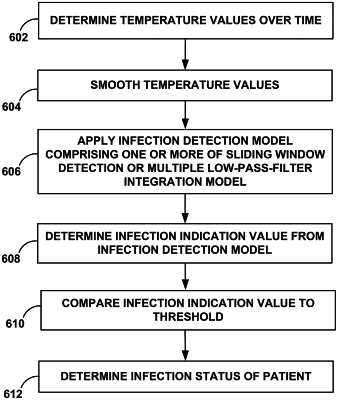| CPC A61B 5/7282 (2013.01) [A61B 5/01 (2013.01); A61B 5/686 (2013.01); A61B 5/7203 (2013.01); A61B 5/725 (2013.01); A61B 5/076 (2013.01); A61B 2562/04 (2013.01)] | 17 Claims |

|
1. A system for determining an infection status of a patient, the system comprising:
an implantable medical device (IMD) comprising at least one temperature sensing device and being configured to be implanted in a patient; and
processing circuitry configured to:
determine, via the temperature sensing device, a first plurality of temperature values over time;
smooth the first plurality of temperature values determined over time to create a first smoothened temperature signal representing changes in the first plurality of temperature values over a first time period;
smooth the first plurality of temperature values determined over time to create a second smoothened temperature signal representing changes in the first plurality of temperature values over the first time period, the second smoothened temperature signal being different than the first smoothened temperature signal;
apply an infection detection model to the first smoothened temperature signal and the second smoothened temperature signal to determine an infection indication value, wherein to apply the infection detection model, the processing circuitry is configured to, compare the first smoothened temperature signal to the second smoothened temperature signal, and increase the infection indication value each time when the second smoothened temperature signal comprises a value that is greater than a corresponding value of the first smoothened temperature signal;
compare the infection indication value to a threshold;
determine, based at least in part on the infection indication value satisfying the threshold, an infection status of the patient;
generate at least one of an alert or instructions for medical intervention for output that is based at least in part on the infection status of the patient; and
transmit the alert or instructions for medical intervention to an external device for use by the patient, a caregiver, or a clinician.
|